 | Make Money Blogging http://www.problogger.net рекомендовать друзьям >> |
- No Matter What Your Blogging Goals for 2012 Are… We've got a 50% Off Deal For You
Over the last week on Digital Photography School we’ve been running a 12 Deals of Christmas promotion where we’re offering some big deals on photography related products over 12 days (each lasting for 24 hours).
A number of readers of both ProBlogger and dPS have asked whether we are going to run a similar promotion on ProBlogger – hoping to pick up some ProBlogger eBooks at a discount.
We were not planning on it but who am I to say no!?!
Starting today we’re running a 50% discount for 3 days on any (or all) of 3 ProBlogger eBooks.
Lets call it the Three-For-Three-At-A-Half Sale (cheesey I know but this is spur of the moment).
Here’s what we’re offering:
For three days you can save 50% on any of these three great blogging eBooks, and there’s something for everyone…
If you’re just getting started …
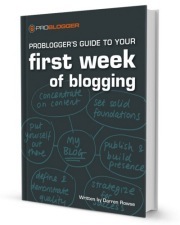 First Week Of Blogging – just $9.99 and it’s yours!
First Week Of Blogging – just $9.99 and it’s yours!Making great early choices is vital to the long-term success of your blog. This ebook guides you, day by day, through your first week of blogging so you can make the most of those critical first few days.
It will ensure you’re blog is build on a rock solid foundation — a Probloggerdation.
If your plans are to turn your blog into a page view power house next year …
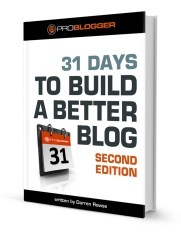 31 Days To Build A Better Blog (2012 edition) just $14.99!
31 Days To Build A Better Blog (2012 edition) just $14.99!New and updated for 2012, 31 Days to Build a Better Blog is a downloadable ebook designed to help you revitalize your blog.
One step at a time, it will transform your blog into the page view powerhouse you've always dreamed of — because we all love seven digit numbers on google analytics!
This is our best selling eBook ever – so join with many others and get involved.
If your plans are to start earning real money from your blog in 2012 …
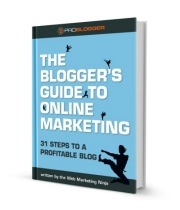 The Bloggers Guide To Online Marketing (normally $99.99) now $49.99.
The Bloggers Guide To Online Marketing (normally $99.99) now $49.99.A comprehensive, 31 chapter blueprint for your blog's ongoing profitability – right from the ground up (AKA more cash!).
Backed by an extensive library of practical templates, printable worksheets, and in-practice example documents, this kit delivers all you need to make your blog turn a profit now, and over the long term.
Three 3 deals are good for 3 days only, so make sure you don’t miss your chance to pick up a last minute Christmas bargain.
Grab one or Grab All Three – But Don’t Delay
I’ve chosen these 3 eBooks because they represent the 3 biggest needs among our readers – starting out, giving things a kick start when they’re slow and making money. So whatever your blogging goals are in 2012 I believe we’ve got you covered.
This sale ends in 3 days time on Friday 23 December at midnight US Eastern time) so don’t delay – they’ll all be full price again from 24th and into the new year.
Originally at: Blog Tips at ProBlogger

No Matter What Your Blogging Goals for 2012 Are… We’ve got a 50% Off Deal For You

Переслать - How to Host Guest Blogs while Building your Credibility
This guest post is by Ronique Gibson of Freshome.
Once you have been blogging for a while, the reality of keeping your content fresh, relevant, and interesting becomes more of a challenge. One way to satisfy these challenges is to host guest blogs on your site. While there are plenty of tips out there on how to be a good guest blogger, what about being a gracious host? Similarly to inviting guests to your home, you want your guests to feel welcome, relaxed, and oh yeah, they should provide a gift to the party—worthwhile content!
On my home decor lifestyle blog Stagetecture, I have hosted close to 300 guest bloggers to my “home,” and along the way I have been able to carefully perfect a system of hosting quality guest bloggers that helps my guests deliver a quality product to my readers and develops my credibility in the process. Here are three tips to help your guests writers want to contribute more, and how your reputation as a quality blog will rise to the top of the competition.1. Know your niche and don't let your guests deviate
Have you ever had a guest come to your dinner party, and they come with a hidden agenda, like trying to recruit your guests for their business? Remember: your home, your rules. Have a clear and concise niche that you are accepting guest posts for, and make it crystal clear in writing for interested guests.
While most guests are genuine, it is not rare to have content pitched to you that subtly veer off-track from the intent of your blog, and the message you want to deliver to your audience.
How to accomplish: Before accepting guest blogs, ensure that your blog has room for opinions, and ideas, and welcomes engagement of your readers.
Develop submission guidelines: Visit a few blogs that you enjoy who welcome guest blogs. Typically, they will have submission guidelines, or you may have to go through the contact form for these. My advice is to put everything in writing on a page that can be easily found on your blog. Include who your blog caters to, desired length of blog posts, if you welcome images, links, and so on. This will save time and energy for both parties.Once your niche and audience is clear, your guests will be clear as to where their creativity and expertise can best be used on your site. You, in turn, will build credibility for your website as a blog that sticks to its niche and values your reader's valuable time.
2. Stay professional and courteous
Have you ever sent out RSVPs for a dinner party where only two people responded, yet 30 people showed up on the night of your gathering? When hosting guest blogs, professionalism and courteousness can take you a long way. I, personally have been on the receiving end of trying to write on another blog, and never received a response.
When hosting guests, reply within a set period of time, and make it your policy. After all, both of you are taking a chance on the other, the rapport that you develop now will make the experience enjoyable for you both, and will in turn show through in the blog post for your readers.
How to accomplish: Keep your contact form linked to an email that you or someone from your blog checks regularly.
Feed back: Provide concise and courteous feedback. Thank the guest for wanting to submit content and work with them to bring their post up to the standards of your blog. For excellent posts, show them your appreciation, and give them a date when it will be published. As a courtesy, I write each blogger and give them a link to their post when it is live. This also helps them promote their post on social media streams, which is a win-win for both of you!3. Build diverse content through guests
The last time you created a guest list for your barbecue, did you choose all guests that were exactly the same, or did you try and mix and match personalities for diversity? Once again, the same scenario is true for hosting guests on your blog.
While you want your guest writers to stay within your blogging niche, you still want to seek out diversity to add interest for your reader, and therefore credibility to your blog as a whole. When I first started accepting guests on Stagetecture, I only sought out home interiors and decor guests, then I realized there was an entire world of do-it-yourself, home maintenance, green home living, and home trade experts out there that I had never tapped into!
In October of this year I was asked by eHow.com to be a resource for their home niche blog content to lend helpful advice to eHow readers. To this day 90% of these posts are from Stagetecture guest blogs.
How to accomplish: Seek out guests through your social media connections, visit similar niche blog sites, and seek out guest blog websites that are a meeting place for a myriad of bloggers. You will be surprised how many resources are out there. When finding guests, you just need to ask, be friendly, and be genuine in your intentions, and your 'guest list' will fill up in no time.
Hosting guest blogs on your website can be rewarding for both parties. Similarly to a perfect party, your guests will love to talk about your blog for months into the future; if they were treated well, enjoyed themselves, and made new friends.
Your website is your home to the world. Create an inviting guest blogger experience and your guests will be asking when the next party will be—and your site will build credibility for being the best place to visit for quality guest-contributed content!
Ronique Gibson is an Associate Architect and a LEED Accredited Professional, who has been in the home design industry for over 13 years. Her writing at Freshome and her guest blog hosting at Stagetecture encompasses her love for architecture, interior design, and family solutions to help make your home the best place it can be.
Originally at: Blog Tips at ProBlogger

How to Host Guest Blogs while Building your Credibility

Переслать - 5 Blogging Lessons from NaBloPoMo
This guest post is by Karen Andrews of Miscellaneous Mum.
As problogger.net reported earlier this year, November is traditionally National Novel Writing Month (NaNoWriMo) and National Blog Posting Month (NaBloPoMo). This year I decided to set myself a personal challenge by giving them a try. Yes, together. In the spirit of imparting some tales of my intrepid adventures, I thought I'd share with you some important (and surprising) things I learned along the way.
1. Don't be afraid to cut away the safety net
Is your blogging routine as old and worn as your favorite pair of slippers? Do you post at the same time on the same day, week in and out?
I see the comfort this can provide, and usually prescribe to the method, but on the other hand might this negate a thing blogging is often known for—the spirit of experimentalism? What if an alternate time, or topic, or way of publicizing your content happened to work even better? Isn't it worth trialling?
2. Application cultivates discipline
It's an old adage that the more a muscle is exercised, the better it performs and is strengthened, and I think this applies to writing. I found that by making the commitment, I found the time I needed to perform my tasks—in batches, I will add, as I have a child at home—and I sat down to work guilt-free and purposeful. This more positive mindset really helped.
3. Creativity rises in the ranks of precedence
It would take a remarkable talent to post thirty straight days (or more) of absolute winning content: talent, planning, assistance, and even a little luck might be closer to the mark. Even the most serious and best of us have silly off-the-cuff days, and I, personally, find them refreshing to both read and write.
It gives you the chance to share a part of yourself that a different kind of reader will identify with and appreciate. If your blog is more business or niche orientated this might be trickier, but I can cite some instances here on problogger.net where Darren has done something similar with great results—like an April Fools joke post which stated that ProBlogger had been acquired by Google, or a special guest post by his son.
So I'm issuing a challenge: post your own photographs instead of sourcing them from creative commons, write some flash fiction. Do you draw? Show us!
4. Determining your blogging future might just be made that much clearer
Once the month is over, stand back and take a breather. You've earned one. But what's next? If you're like me, worrying about traffic and subscribers takes a backseat when you're in the middle of the task of laying down words until you emerge from the fog. Lucky there's a wealth of information waiting to be looked over via Feedburner or Statcounter or Google Analytics (if you choose to do so).
Sometimes you'll be able to tell what worked “better” by commenter count or good old gut instinct. The question now is: which way will you go? Will you apply your new tactics or chalk them up to mere play? It's never an easy question to answer, but think about it this way: you're better situated to do so now than you were a month ago.
5. This above all: life happens. Make peace with the fact
Did I finish NaNoWriMo? No, I barely cracked the 3,500 word mark. What happened? Illness, end-of-year school concerts, events, errands. You know the usual excuses. Still, those 3,500 are better than nothing—which might have happened if I hadn't signed up at all. Besides, I still met the NaBloPoMo goal.
I believe above all else that the best thing you can offer your blogging is the best you. This might mean taking a rest or postponing such challenges if they become too untenable. The best thing of all is, you've got the next thirty days, you can begin again. Go solo if you want, you've already got the practice in. Maybe recruit some blogging buddies, and make it a community project. You can do it.
Karen Andrews is an author, publisher at Miscellaneous Press, award-winning short story writer and poet. She is also known through her personal blog as ‘Miscellaneous Mum‘. She is on Twitter as @miscmum.
Originally at: Blog Tips at ProBlogger

5 Blogging Lessons from NaBloPoMo

Переслать - 6 Steps to a Loyal Blog Following
This guest post is by Shari Lopatin of www.sharilopatin.com.
I had a writer friend tell me the other day I have the best social network she's ever seen.
"What?" I asked, shocked. After all, I only have about 380 Twitter followers (I follow 200-something). "You should check out these people instead," I offered, with three other usernames. "They have way more followers than me."
But she persisted. "They may have more followers, but your network is much more engaged."
Engaged.
So many people think the more followers you have, whether on Facebook or Twitter or your blog, the better. But numbers aren't what counts. Who cares if you have 20,000 followers, when no one pays attention to your posts?
Six tips to engage your networks
Whether you're selling a product, a service, or even your writing, you want people to care.
The key is to build loyalty. My writer friend discovered the loyal nature of my network when I tweeted a question for her. She immediately began receiving tons of responses. What does that mean?
My followers are listening to me—and taking action.
Your social networks will eventually convert into (loyal) blog followers. I've had many blog subscribers discover me on Twitter. But just how do you get people to care? Well…
1. Reach out
Twitter is abuzz with tons of professionals looking to connect. Use Twitter's "search" feature to type in keywords related to your business. For example, if you're a writer, search "writing." Begin following people tweeting about this topic, and see who follows you back. Then study their Twitter profiles.
What's their follower/following ratio? Do they seem engaged with their network? If so, take it a step further. Visit their blog. Comment on their posts. Reply to their tweets, and maybe even fan them on Facebook. Then, direct message them on Twitter (or email them through their site) and invite them to guest post for your blog about their expertise. This will develop a trusting relationship with people who have the ability to influence their networks for your site.
2. Promote others
This can be done on Facebook, on Twitter, and even on your own blog. Let's say you're a lawyer, looking to build your expert status. Follow the steps in #1 to find other influential lawyers who offer great advice. Then, tweet a link to their site or blog post (i.e. "Great advice on handling angry bankruptcy clients from @joesmithlaw, www.joesmithlaw.com/bankruptcy"). Do the same on Facebook.
This does two things: first, it lets your followers know you're not selfish, and you're out to educate them (which builds trust). Second, people feel flattered you thought their work relevant enough to share, and they'll most likely return the favor.
3. Respond
Everyone knows you should always answer questions posted to your Facebook page. But let's take this a step further. Maybe you're a media consultant. So use Twitter's search feature to type in keywords like "blog." From there, seek out general questions you can answer (i.e. "Anyone know how to connect my WordPress blog to Twitter?"). @Reply, and answer it! Maybe even follow the person.
If someone you follow poses a general question in your newsfeed, answer it, too. People want to be heard, and you can gain new (loyal) followers this way.
4. Ask questions
People love talking about their thoughts and opinions. For example, on my blog, I always ask a question at the end of my posts. For a recent topic, I wrote about, "Kindles: Writer's Best Friend, or Worst Enemy?" Rather than just finishing with my thoughts, I asked my readers, "What do you think? Are Kindles securing our relevancy as writers, or helping to kill our profession and demand?" That generated 24 comments. You can also pose questions on your Facebook page related to your business, and watch the responses pour in.
5. Cross-promote
This one is my favorite, and one of the most under-utilized, strategies. I recommend it all the time. When another expert guests for your blog, have them cross-promote to their networks. Ask them to run a blog post driving traffic to your site the day their article runs. Have them promote it on Twitter, on Facebook, on Google+. And you do the same.
On average, I've seen this technique double the traffic to a website in one day. Plus, if you partner with someone influential, new visitors will be more likely to subscribe to your blog, follow you on another social network, and best of all … engage with you moving forward!
6. Be real
Don't sound like a product or corporation. No one wants to interact with a brand (unless you're Coca Cola or Nike). Sound like a real person who people can connect with. But beware! Don't overshare—just offer enough to make yourself real to your followers (i.e. Relate to my opening story in this post).
I've found the golden rule of social media is this: the more you give, the more you get.
What do you think? Do you find highly engaged social networks equate to more loyal customers and blog followers? How do you develop relationships with your followings?
Shari Lopatin is a former daily newspaper reporter who now works in the corporate world as a professional writer, journalist, and media strategist. Find her on Twitter at @ShariLopatin, or read more of her marketing and writing tips on her blog, "Shari Lopatin: Rogue Writer."
Originally at: Blog Tips at ProBlogger

6 Steps to a Loyal Blog Following

Переслать - How to Use Images in Your Blog Posts
This guest post is by Karol K of ThemeFuse.
“A picture is worth a thousand words.”
I’ve always liked this adage even though it’s one of the biggest cliches ever. Pictures, photos, image—they are all great for visualizing your posts and making them more memorable.
I know that it’s the content of the book that’s important, but what would be a book without a nice cover? Okay, let me stop being poetic and get straight down to business.
Why you should use images in your blog posts
1. They help your written content to deliver the intended message with a bigger impact
There’s really no better way of doing this. If you want to really emphasize a strong point, you can do it by writing it in bold as a separate paragraph and then placing an image next to it. Of course, the image has to be of some relevance to the text, or it won’t work.
2. They make your post more memorable
We humans need an anchor of some kind to memorize things. Most of us tend to remember things in snapshots—by visualizing them. It’s not natural for us to remember something as text—a set of words and sentences. It’s difficult to make a snapshot of a piece of text. Images do this job a lot better.
(Quick note. Sorry, but a headline is still the most important factor for every blog post. Just wanted to make this clear.)
3. They break the text visually
In most cases, reading from a computer screen is not comfortable. Eyes get easily tired, you can’t be staring at a computer screen for more than an hour at a time, and let’s face it, sitting at your desk is not the most comfortable position either.
Images are not the magic-bullet solution to make all of these go away, but they do make it easier for the reader. If the text is long you—the author—absolutely must break it down into smaller chunks.
The first rule of breaking it down is to use short paragraphs, no longer than four to six lines. However, even if you’re doing this, you will still end up with a number of paragraphs, and they need to be broken down too. The solution: images.
When you place an image every six to ten paragraphs, the text gets really reader-friendly. Everyone can easily follow your way of thinking and do a little five-second break to look at an image. And then they can easily return to the place where they’ve left off.
I’m sure that there are many more reasons for using images, but I’m confident that the above prove my point well. And, of course, I’m not even going to discuss the situations in which a blog is totally image-driven, like all kinds of photo blogs, for example.
What’s the best place for an image?
I’m no guru here, but I think that the best place is the beginning of a post (somewhere near the headline). It’s where the reader looks first, so if we want to help them to memorize anything, this is the placement to use.
Of course, you can use more than one image in a blog post. So my recommendation is to use the first image at the beginning, and then spread other images evenly throughout the post so they do their job of breaking the post down visually. Which brings me to the next point…
Don’t use too many images in short posts.
Images should make reading easier not harder. If you break the text too much, the whole purpose loses its sense and turns into an obstacle.
The perfect number of images per post for your blog is for you to decide. It depends on the blog’s design, the average post length, and the content of the post as well. You can find your number by testing a couple of possible setups and deciding which one works best.
The size of images
The maximum size you can use is the width of the content block on your blog. So again, it’s design-dependent.
That being said, the most common approach is to use images that are smaller (except for photography blogs) rather than bigger. That’s because the image is just there to aid you in conveying the message; it’s not to be the message itself.
An image is an extra element. If it’s too big it becomes the main element. I’d advise you to use images that are either not wider than one-third of your content block width, or even up to the whole width but really small in height.
Now, there’s an exception to this rule—screenshots.
Screenshots usually work as main elements of a post, so they need to be bigger. Also, they need to be bigger for readers to be able to see clearly what’s on them. Another approach is to present a screenshot as a thumbnail along with a lightbox gallery link.
How to embed pictures on your blog
Before you stop reading, bear with me! I know that this is basic and everybody knows this, so there are only two things I want to tell you here.
- Upload images in the exact dimensions you intend to use: always resize your image to the exact size you’ll use in a blog post. Bigger pictures consume more space than smaller pictures, so there’s no point in uploading a large picture and then scaling it down inside of WordPress.
- Use an image optimizer plugin: something like WP Smush.it. I’m not going to go into technical details because, to be frank, I have no idea how it works, but what I do know is that it optimizes the size (the disk size, not the dimensions) of images with no loss of quality. And it’s free.
Remember attribution
There are basically three types of images you can use:
- your own images
- free images
- paid images (usually referred to as royalty-free images).
Attribution is a thing you need to have in mind when using free images. It depends on the license a given image is shared with, but what you usually have to do is to somehow attribute the image to its author or creator.
The most popular way of doing this is by placing a link to the original image in your post. Some image directories require you to do this, and some don’t.
Treat attribution as a payment for the image—which essentially is exactly the case.
Do you have any strategies for using images on your blog you’d like to share? Feel free to share your opinion and advice in the comments.
Karol K. is a 20-something year old web 2.0 entrepreneur from Poland and a writer at ThemeFuse.com, where he shares various WordPress advice. Don’t forget to visit ThemeFuse to get your hands on some original WordPress themes (warning: no boring stuff like everyone else offers).
Originally at: Blog Tips at ProBlogger

How to Use Images in Your Blog Posts

Переслать - How I Bumped My RSS Conversion Rate from 16% To 25%
This guest post is by Gab Goldenberg, of The Beginner’s Guide To Usability Testing.
Want to find out how to boost RSS subscriber conversion? I did, but I hardly found any information about it online!
Besides having an obvious call to action above the fold and getting to [social news site]‘s front page, the blogosphere doesn’t much discuss how to convert more readers to subscribers.
I’d been meaning to test my RSS subscription page for a while, and finally got around to it. Here’s what the old page looked like:
The RSS subscription page was way too busy!
Notice the loads of links on the page? There’s the sidebar navigation, the breadcrumbs, the main navigation…
Additionally, the benefits copy is above the calls to action, which pushes them below the fold.
The conversion rate theory and the execution
My hypothesis was that by eliminating the distractions I would increase conversions. In other words, I’d eliminate the links on the page and move the benefits below the calls-to-action.
The reasoning for moving the benefits copy was that if someone clicked to view the subscriptions page, they were probably already pretty convinced and should be shown the conversion form and button immediately.
People who were still hesitant once they got to the page would be able to scroll down and read the benefits copy. That’s also why I moved the reassurance text (“You can unsubscribe with a single click, anytime”) below the form.
Finally, I did one more thing, which wasn’t originally in the plan, but which my limited HTML/CSS/Photoshop skills forced: I added testimonials into the left-hand sidebar. I’d initially planned to get rid of the sidebar, but that broke the page’s alignment and looked bad.
(Since my site is powered by WordPress, I used this Google Website Optimizer-Wordpress workaround to be able to use GWO. That’s because I never had a successful experience using GWO with WordPress, partly because GWO isn’t designed for sites that use a content management system, because I have a custom theme, and because many of the plugins are bad quality.)
Here’s what the page looked like after I edited it:
And here are the results:
That’s right, the variation outperformed the original by 56.3%—I added nine points of conversion to my overall conversion rate!
Methodology
I want to mention how conversions were measured. The limits of Google Website Optimizer (GWO) forced me to only measure one goal, so I chose the email subscription instead of a click on the orange button.
What that means is that I don’t know the difference these changes made on conversions for people clicking on the RSS button. Or should I say, this test didn’t reveal the difference these changes made…
Initially, my goal was to measure results comprehensively. After a fair bit of struggling, I followed the instructions on GWO’s help site and altered their code and mine so that both email subscriptions and RSS button clicks would be counted.
I launched the test and was happy until I discovered that something was causing the pages to load very slowly. I’m talking about 30 seconds for a page with the main functionality and 60+ seconds for full load.
Despite that, it seems some people did wait (or didn’t have this problem?) and early results of the test looked like this:
Notice the 11/11 conversion rate for the variation? That’s right, a 100% conversion rate for the variation! And why not? If visitors clicked my sidebar link to go to the subscriptions page (i.e. this was highly motivated traffic), and they saw a simple page without distractions, and with a very easy conversion process, doesn’t it make sense that they’d then convert?
Sure, it’s probably just a lucky streak and with more traffic we would have likely seen the conversion rate drop to 90% or such, but the point is that the no-distractions page still kicks butt—and takes names.
Unfortunately, no matter what I tried, I couldn’t solve the load time problem, though. So I started a new test, only measuring a single goal: email subs. And that’s where the data above comes from.
Another very interesting finding is that, contrary to the common situation of email subs being more numerous than RSS subs, it seems my techie audience prefers RSS. If about 30% are converting by email, and the no-distractions page gets say 90-100% conversion rate, then potentially 60-70% of my visitors prefer RSS subscriptions.
Of course, I’ll need to test some more to find out!
Want to help other bloggers and email marketers increase RSS conversions? Share your own experiences with RSS conversions below!
This guest post is by Gab Goldenberg, author of the advanced SEO book and The Beginner’s Guide To Usability Testing.
If you liked this post, get Gab’s posts by email or RSS -free- plus enjoy the subscriber only downloads!Originally at: Blog Tips at ProBlogger

How I Bumped My RSS Conversion Rate from 16% To 25%

Переслать
 | Интернет-инструменты для малого бизнеса Практические приемы интернет-маркетинга. Saas-решения для малого бизнеса. Опыт малого бизнеса . Присоединиться → |
| rss2email.ru |
| rss2email.ru | отписаться: http://www.rss2email.ru/unsubscribe.asp?c=12354&u=1052515&r=672244627 управление подпиской: http://www.rss2email.ru/manage.asp партнерская программа: http://partner.rss2email.ru/?pid=1 |

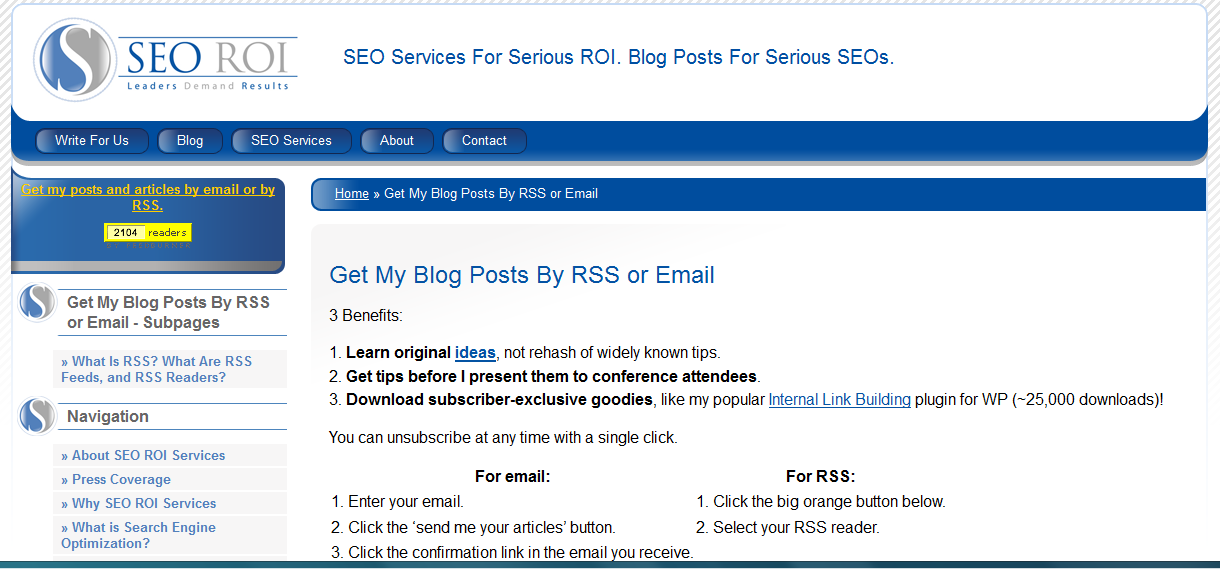
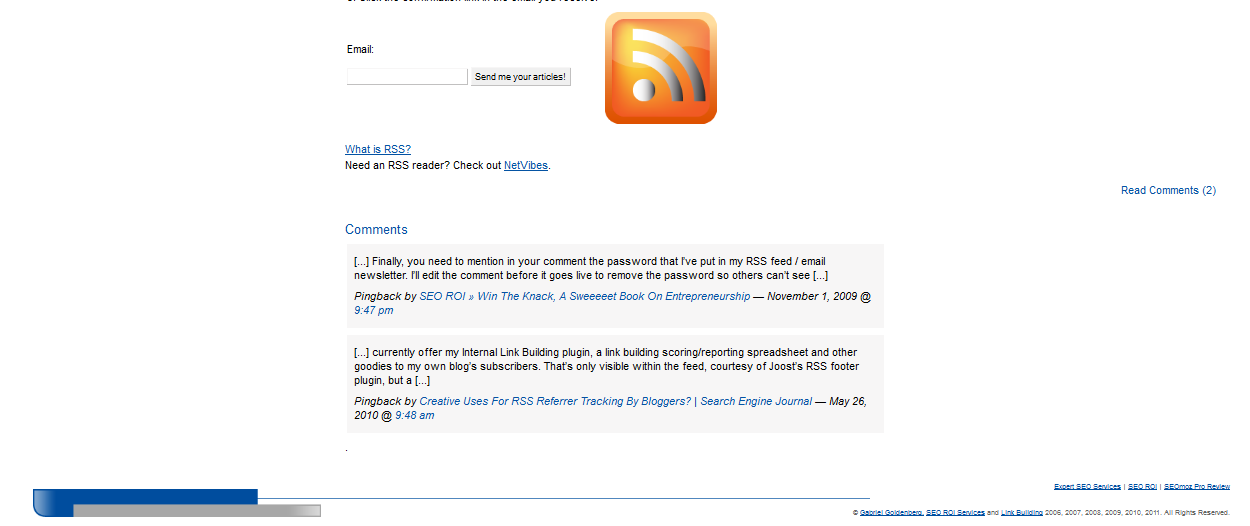
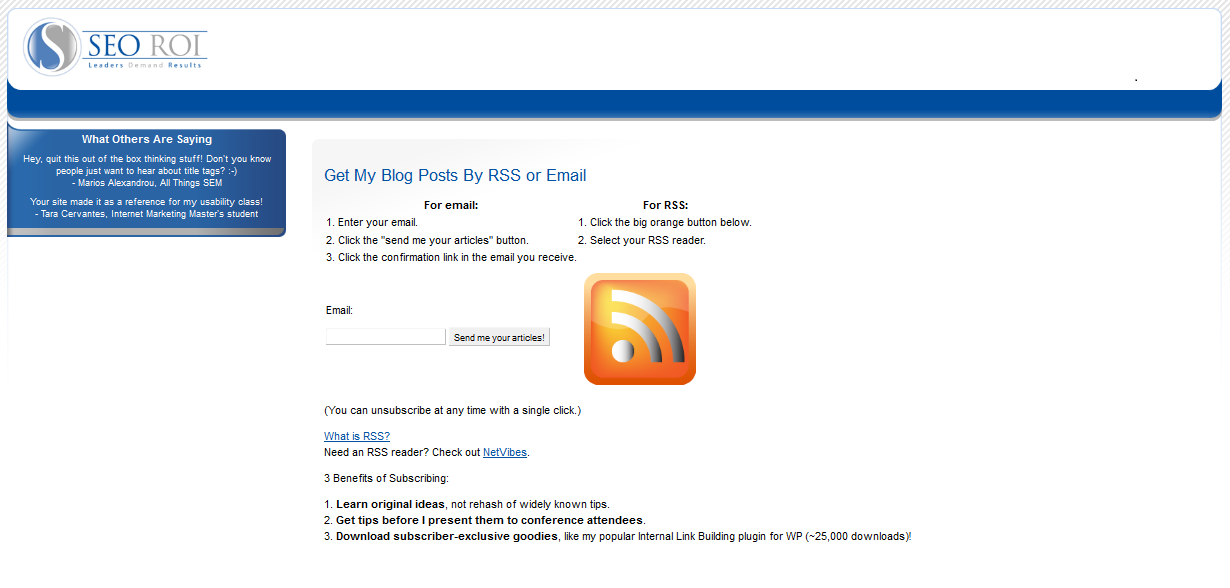
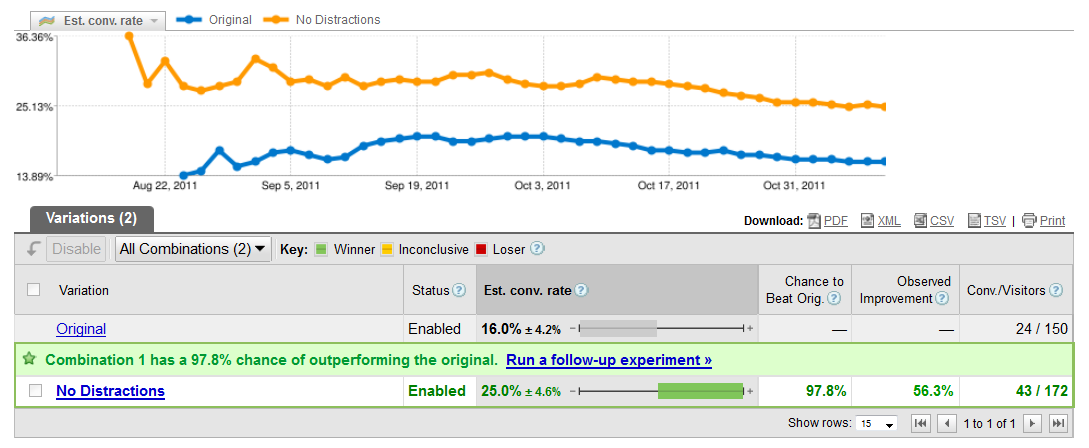

Комментариев нет:
Отправить комментарий